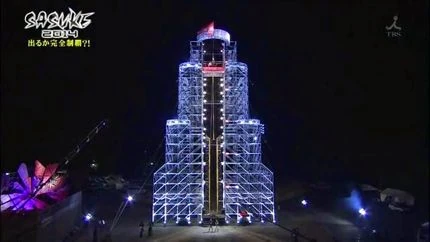Jessie Graff
With how physical American Ninja Warrior can be, some might assume that all of the competitors are male. This assumption could not be further from the truth, in large part due to Jessie Graff.

Like many other athletes on ANW, Jessie has a background in gymnastics. In fact, Jessie took part in competitive gymnastics for a considerable part of her life. In school, she transitioned into the pole vault, competing at the NCAA level. She currently holds the pole vault record at Georgia Tech and Nebraska University. In addition to gymnastics and pole vaulting, Jessie took circus classes at an extremely young age and has multiple black belts. All of these experiences have created the dynamic athlete required to succeed in American Ninja Warrior. Jessie is not all brawn, however. She intended to major in Aerospace Engineering at Georgia Tech, continuing from her success as a member of the National Honor Society in high school.
Jessie Graff doing a back handspring in a dress at the 2016 Emmy’s
After graduating from college, she became a professional stuntwoman. She has acted as a stuntwoman in films such as X-Men: First Class, Live Free or Die Hard, and Transformers: Revenge of the Fallen and in television shows such as Agents of Shield, NCIS, and, most recently and famously, Supergirl. Jessie’s athletic accolades are stellar, and her body of work as a stuntwoman speaks for itself. Graff had even competed on a different obstacle course show, Wipeout. She has truly earned her fame, however, through American Ninja Warrior.

In ANW5, Jessie hit the ground running. She became the first woman to qualify for a City Finals course, wearing a chicken costume no less. Before she could follow up that success, Jessie unfortunately tore her ACL, TCL, and meniscus. While Jessie was away, Kacy Catanzaro became the first woman to climb the famed Warped Wall. When Jessie returned, however, she came back with a vengeance. Graff reached the national finals in Las Vegas, but the dreaded warped wall prevented her from going any further.

Entering ANW8, Jessie faced an even taller challenge: the Warped Wall grew to fourteen and a half feet after the success of Ninja champions Caldiero and Britten. In the qualifying round, Jessie had to face the Warped Wall. Unlike her previous attempts, Graff overcame the obstacle. She became the first woman to climb the new, taller Warped Wall. During her Stage 1 run at the National Finals, Jessie successfully climbed the Warped Wall with an ever shorter run-up. Graff proceeded to complete Stage 1, the first woman to ever do so.

As a member of the USA team in the special USA vs the World competition, Jessie completed Stage 2. Though this run was not during season competition, this run immortalized Graff as the first woman to compete for the USA team and as the first woman to complete Stage 2.

Jessie Graff is a trailblazer, disproving any misconceptions about female competitors not being good enough to compete, while acting as a wonderful role model. Jessie Graff is an exceptional athlete and an integral part of the American Ninja Warrior past, present, and future.
Sources
<https://www.iaaf.org/athletes/united-states/jessica-graff-192957>
<https://www.martialartsentertainment.com/jessie-graff/>
<http://m.imdb.com/name/nm2421085/>
<https://www.usatoday.com/story/life/entertainthis/2016/08/29/american-ninja-warrior-jessie-graff/89563008/>



